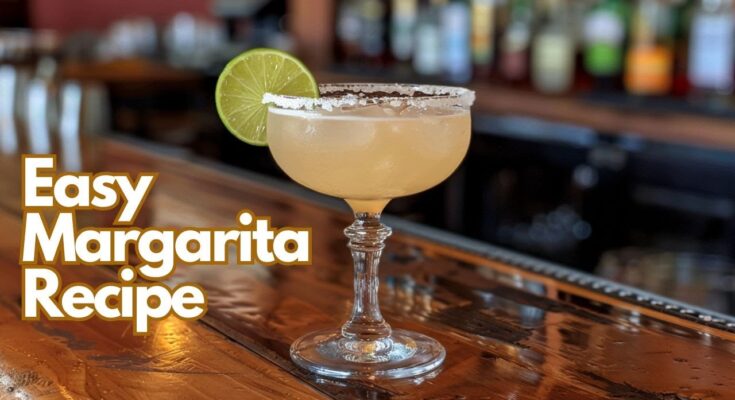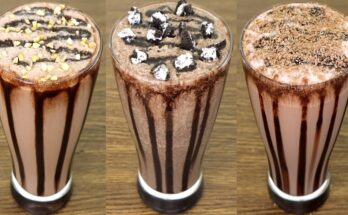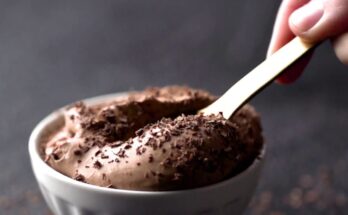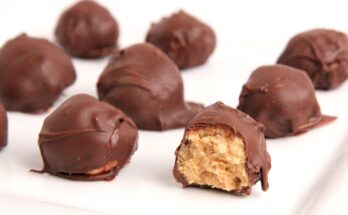Traditional Margarita Recipe: The Margarita, one of the world’s most beloved cocktails, has a mysterious and spicy history just like the drink itself. While several stories vie for its origin, most trace it back to Mexico in the 1930s or 40s. One version credits socialite Margarita Sames for mixing it up at a party in Acapulco. Another attributes the drink to a Mexican bartender who created it for a showgirl named Margarita. Whichever tale is true, one thing’s certain: this citrusy cocktail quickly climbed the ranks to become a global icon.
A Margarita is more than a drink; it’s a cultural staple that brings sunshine into a glass. From beach resorts to rooftop bars, this zesty cocktail has become synonymous with fun, relaxation, and fiesta vibes. With just three core ingredients—tequila, lime juice, and triple sec—it showcases simplicity at its finest. Unlike overly complex drinks with ingredient lists as long as a grocery receipt, the Margarita is refreshingly straightforward.
Why the Margarita Remains a Favorite
What makes the Margarita stand the test of time? First, it’s incredibly adaptable. You can go classic, frozen, spicy, fruity, or smoky—yet its essence remains unmistakable. Second, it pairs beautifully with food, especially spicy and salty dishes. Lastly, it’s easy to make at home with minimal tools, making it perfect for both casual sipping and special celebrations.
The Margarita’s refreshing combination of tart citrus, smooth tequila, and sweet orange liqueur creates a taste profile that hits all the right notes. It’s tangy, slightly sweet, with a subtle warmth from the alcohol—a balanced experience that pleases even picky palates. Whether you’re lounging poolside or hosting Taco Tuesday, a Margarita fits right in.
Ingredients You’ll Need
The Key Three – Tequila, Lime Juice, Triple Sec
To make a traditional Margarita, all you need are three essential ingredients. This holy trinity delivers the flavor and character that defines this classic cocktail.
- Tequila: Use 100% agave blanco tequila for the best results. Blanco (or silver) tequila has a clean, crisp taste that works beautifully with the citrus elements of the drink. Avoid mixto tequilas which contain less than 51% agave—they often produce a harsher flavor and lingering hangovers.
- Fresh Lime Juice: The soul of a good Margarita lies in the lime juice. Always opt for freshly squeezed limes over bottled versions. Bottled juice often contains preservatives that mute the flavor, while fresh lime delivers a vibrant tang that’s irreplaceable.
- Triple Sec: This is an orange-flavored liqueur that adds sweetness and depth. The most popular options are Cointreau and Grand Marnier, though classic Triple Sec is perfectly acceptable. The balance between this sweetness and the lime’s acidity is what gives the Margarita its signature zing.
The standard ratio for a traditional Margarita is:
- 2 oz Tequila
- 1 oz Lime Juice
- 1 oz Triple Sec
This 2:1:1 ratio keeps things balanced and flavorful.
Optional Additions for a Personalized Touch
While purists might scoff, there’s nothing wrong with a little customization. A splash of agave syrup can mellow the acidity if you prefer a sweeter drink. A few drops of orange or grapefruit bitters can add a twist. Want a smoky edge? Swap in mezcal for tequila. Even a pinch of chili salt on the rim can elevate the experience.
But remember—less is more. The beauty of a Margarita is its simplicity. Don’t go overboard and dilute what makes it great in the first place.
Tools Required to Make the Perfect Margarita
Bar Tools Checklist
To whip up a top-tier Margarita, a few tools make the process easier and more enjoyable. Here’s your basic bar setup:
- Cocktail shaker: A must for mixing and chilling the ingredients quickly.
- Jigger or measuring cup: Accurate ratios are key to a well-balanced drink.
- Citrus juicer: To squeeze fresh lime juice efficiently without straining your wrist.
- Bar strainer: Ensures no pulp or ice gets into your final pour.
- Small plate: For salting the rim.
These tools are affordable, easy to find online, and elevate your cocktail game significantly.
Glassware: Why It Matters
While a Margarita can technically be served in any glass, presentation matters. The traditional vessel is the Margarita glass—wide-brimmed with a stepped shape. It allows for that signature salted rim and gives the drink a festive appearance.
Alternatively, many bartenders now prefer a rocks glass (a short tumbler), especially when serving Margaritas on the rocks. It’s less prone to spills and more contemporary in style.
The glass should always be chilled before serving. Pop it in the freezer for 10 minutes or fill it with ice water while you prepare the drink, then dump the water before pouring.
Step-by-Step Guide to Making a Traditional Margarita
Step 1: Prepare Your Ingredients
Preparation is everything when it comes to cocktail crafting. Before you even touch your shaker, gather all the ingredients and tools. Squeeze your limes—don’t just eyeball it. For each drink, you’ll need about one full lime to yield an ounce of juice. Use a hand juicer to extract every last drop.
Measure your tequila and triple sec using a jigger. The balance here is crucial: too much tequila can overpower the citrus, and too much triple sec can make it cloyingly sweet. Stick to the 2:1:1 ratio for a well-rounded flavor.
Once all your ingredients are measured, place them close by, and have your shaker ready with a few ice cubes. Timing matters—mixing a Margarita too early will cause the ice to melt and dilute the drink before you even take a sip.
Also, if you’re salting your glass rim, now’s the time to prep it before shaking the drink.
Step 2: Rim the Glass with Salt
A salted rim is a classic Margarita hallmark. It adds a savory contrast to the tart-sweet cocktail and elevates every sip. Here’s how to do it right:
Start by cutting a lime wedge. Rub it along the edge of your glass to moisten the rim. Then, dip the glass into a small plate filled with coarse kosher salt or Margarita salt—avoid fine table salt as it tends to clump and taste overly sharp.
Tip: If you don’t want a fully salted rim, just salt half the glass. That way, each sip gives you the choice of salty or clean.
For an extra twist, you can mix a bit of chili powder or Tajín with the salt. This adds a smoky, spicy layer to the drink that many Margarita lovers swear by.
Once the rim is done, place the glass in the freezer to chill while you move on to the next step.
Step 3: Shake the Cocktail
This is where the magic happens. Add all your measured ingredients into the cocktail shaker filled with ice. Secure the lid tightly—no one wants a tequila bath—and shake vigorously for 15 to 20 seconds. You want to chill the drink thoroughly and slightly dilute it for a smoother finish.
Shaking the cocktail does more than mix the ingredients; it aerates the drink and balances the flavor. You’ll know you’re done when the shaker becomes frosty on the outside—that’s your cue.
If you’re using a Boston shaker (two-part), tap the side gently to break the seal before opening. If using a cobbler shaker (with a built-in strainer), unscrew the top cap and get ready to pour.
Step 4: Pour and Garnish
Once your drink is thoroughly shaken, grab the chilled glass from the freezer. Use a bar strainer to pour the Margarita into the glass. This will catch any bits of ice or pulp and leave you with a silky-smooth cocktail.
If you’re serving it on the rocks, pour it over fresh ice in the glass. If you prefer it straight up, skip the ice for a cleaner presentation.
Garnishing is optional but adds a professional flair. A simple lime wheel or wedge on the rim of the glass works beautifully. For a touch of style, you can even float a thin slice of jalapeño or a twist of orange peel on top.
Now step back, take a photo (you know you want to), and enjoy your perfectly crafted traditional Margarita.
Tips for the Perfect Margarita Every Time
Choosing the Right Tequila
Let’s talk tequila. It’s the backbone of your Margarita, so don’t skimp. Always look for 100% agave tequila—anything less, and you’re drinking fillers and added sugars.
There are three main types to consider:
- Blanco (Silver): Unaged or lightly aged, it’s bright, peppery, and perfect for cocktails.
- Reposado: Aged in oak barrels for 2–12 months. It adds depth and a soft caramel note.
- Añejo: Aged over a year, best sipped straight, not ideal for cocktails.
For traditional Margaritas, Blanco tequila is your best bet. It’s crisp and clean, allowing the lime and orange flavors to shine through.
Brands like Espolòn, El Jimador, Olmeca Altos, or Patrón offer excellent quality without breaking the bank.
Fresh vs. Bottled Lime Juice
There’s no polite way to say this—bottled lime juice is a crime against good cocktails. It’s flat, acidic, and lacks the natural oils that give fresh juice its zing.
Squeeze limes right before you mix. If you’re making drinks for a crowd, you can juice them in advance—just store it in an airtight container in the fridge and use it within a few hours.
Pro tip: Roll the limes on the counter with a little pressure before cutting. This helps release more juice and saves your hands some squeezing strain.
For added citrus aroma, zest a bit of the lime peel into the shaker or rub it on the rim before salting.
Balancing the Sweet and Sour
The Margarita is a delicate dance between sour lime and sweet orange liqueur. If either dominates, the drink falls flat. That’s why sticking to the classic 2:1:1 ratio is so effective.
However, taste is subjective. Some like it more tart, others lean sweet. Adjust with a dash of agave syrup or an extra splash of lime juice until it hits your personal sweet spot.
If you’re feeling experimental, you can infuse your simple syrup with herbs like basil or mint to give the drink a fresh twist. But always taste-test before serving—balance is key.
Common Mistakes to Avoid
Overpouring the Tequila
Sure, tequila is the star of the Margarita, but that doesn’t mean it should dominate the entire flavor profile. One of the most common mistakes beginners make is overpouring the tequila, thinking it’ll give the drink more kick or flavor. In reality, this throws off the balance and turns a smooth cocktail into a boozy mess.
The Margarita is a lesson in harmony. If you add too much tequila, the citrus and orange liqueur won’t be able to balance it, and you’ll end up with a drink that burns instead of refreshes. Stick to the classic 2-ounce pour, and only adjust after tasting. Respect the ratio—it exists for a reason.
If you really want a stronger drink, make a double. But never sacrifice balance just for a buzz.
Using Crushed Ice Instead of Cubes
While crushed ice is great for frozen Margaritas, using it in a traditional on-the-rocks version is a big no-no. Crushed ice melts rapidly, diluting your drink way too quickly. Within minutes, your carefully crafted cocktail becomes a watery, tasteless puddle.
Instead, use medium-sized ice cubes that chill the drink without overpowering it. Want to be fancy? Use large-format cubes or clear ice if you have molds at home. They melt slower and look stunning in the glass.
And always use fresh ice when serving. The ice you shook with is warm and partly melted—don’t reuse it.
Neglecting the Garnish
Some people see garnishes as optional fluff, but in a Margarita, a simple lime wedge isn’t just decorative—it enhances the aroma and even the taste. The citrus oils from the lime peel can add depth to each sip.
More importantly, a garnish makes your drink look complete. It tells whoever you’re serving (even if it’s just you) that you put effort into the presentation. And let’s be honest, everything tastes better when it looks good.
Try variations like dehydrated lime wheels, orange twists, or even a jalapeño slice for spice.
Variations of the Classic Margarita
Frozen Margarita
Want a more tropical, slushy experience? Enter the frozen Margarita. Blend your standard ingredients with a generous scoop of ice until smooth. The texture is thicker, the chill is deeper, and the vibes are pure summer vacation.
You’ll need a strong blender to pulverize the ice and make a smooth, drinkable consistency. Add more lime or sweetener to balance the flavor as blending can sometimes mute the taste.
Pro tip: Use slightly less alcohol for frozen versions to keep it smooth and refreshing.
Spicy Margarita
If you like a little heat, a spicy Margarita might be your new favorite. Muddle fresh jalapeño or serrano slices with the lime juice before shaking. The heat pairs surprisingly well with the citrusy brightness of the cocktail.
For a smoky edge, use mezcal in place of tequila. You can also rim the glass with Tajín or chili salt to amplify the spice.
Balance is critical—don’t go overboard on the spice. A little goes a long way.
Fruit-Flavored Margarita
Fruit additions are a great way to customize your Margarita without straying too far from tradition. Try fresh or puréed strawberries, mangoes, blackberries, or pineapple. Muddle them with lime juice, or add to the shaker for a fruity twist.
These are perfect for summer parties or when you want something colorful and Instagram-worthy. Just adjust your sweetener, as fruits can change the sugar profile of your cocktail.
Pairing Margaritas with Food
Mexican Cuisine Staples
There’s a reason Margaritas and tacos are a match made in culinary heaven. The acidity from the lime cuts through rich, cheesy, or spicy Mexican dishes. Try pairing Margaritas with:
- Tacos (especially shrimp or carne asada)
- Guacamole and chips
- Nachos with spicy jalapeños
- Enchiladas with mole or salsa verde
The Margarita refreshes your palate between bites and enhances the flavors of the food without overwhelming them.
Grilled and Barbecue Dishes
Margaritas also work wonderfully with grilled meats and BBQ. Their citrusy brightness acts like a squeeze of lemon over your ribs or grilled chicken. Try them with:
- BBQ pulled pork
- Grilled chicken wings
- Charred vegetables
- Corn on the cob with lime and cotija cheese
And don’t forget: spicy rubs or sauces pair great with spicy or smoky Margarita variations.
Light and Vegetarian Fare
Veggie lovers, rejoice. Margaritas also pair beautifully with lighter dishes. Try them with:
- Ceviche or shrimp cocktails
- Fresh salads with citrus dressings
- Veggie quesadillas or mushroom tacos
- Tofu fajitas with grilled peppers
The cocktail’s zing complements fresh produce and light proteins without overpowering the delicate flavors.
Serving the Margarita Right
How to Batch for a Party
Throwing a party? No one wants to play bartender all night. You can batch your Margaritas in advance and store them in a large pitcher or beverage dispenser.
Stick to the same ratio:
- 2 parts tequila
- 1 part lime juice
- 1 part triple sec
For a party of 10:
- 20 oz tequila
- 10 oz lime juice
- 10 oz triple sec
Chill the mixture in the fridge and stir before serving. Don’t add ice until you’re ready to pour so it doesn’t dilute. Set out a salted glass station and let guests rim their own glasses and garnish as they please.
Glass Presentation Tips
Want to impress? Presentation goes a long way. Chill your glasses, use beautiful garnishes, and don’t overfill. A well-presented drink makes people feel special—even if they made it themselves.
Get creative with your rims too. Mix coarse salt with sugar for a sweet-salty combo or add edible flowers or herbs for a gourmet touch.
Healthier Margarita Alternatives
Low-Calorie Margarita
Watching your sugar intake? You can still enjoy a Margarita without blowing your calorie count. A traditional Margarita can contain up to 300 calories per glass, mostly from triple sec and sweetened mixers.
To lighten it up:
- Use fresh lime juice only (no sugary mixers).
- Swap triple sec for orange-flavored stevia drops or a low-calorie orange extract.
- Add a splash of soda water to stretch the drink and lighten the mouthfeel.
You’ll cut out a lot of sugar without sacrificing that tangy-sweet flavor. Keep the tequila quality high and the garnish simple.
No-Sugar Margarita
If you’re on keto or diabetic, a no-sugar Margarita can still hit the spot. Here’s a quick version:
- 2 oz tequila
- 1 oz fresh lime juice
- Liquid stevia or monk fruit to taste
- Optional splash of sparkling water
This variation gives you the same refreshing vibes without any added sugar or carbs. Serve it over ice with a salted rim and you’re good to go.
Organic and Clean Ingredient Options
Want to go the extra mile for clean eating? Choose organic tequila, sourced from sustainably grown agave. Pair it with freshly squeezed organic limes and natural sweeteners like agave nectar (in moderation).
Some craft brands even offer low-calorie, clean-ingredient liqueurs and syrups, so you can build a truly health-conscious Margarita without losing the flavor punch.
FAQs about Traditional Margarita Recipe
1. What are the essential ingredients in a traditional margarita?
A classic margarita includes just three main ingredients: tequila, fresh lime juice, and orange liqueur (like Triple Sec or Cointreau). Some recipes also include a dash of simple syrup for sweetness.
2. What type of tequila is best for a margarita?
Blanco (silver) tequila is the most commonly used for traditional margaritas. It has a crisp, clean flavor that mixes well with citrus.
3. Can I use bottled lime juice instead of fresh?
Fresh lime juice is strongly recommended for the best flavor. Bottled juice can taste artificial and overly sour.
4. How do I make a margarita without alcohol?
For a non-alcoholic version, swap tequila with sparkling water or club soda and replace orange liqueur with orange juice or a splash of non-alcoholic orange syrup.
5. Should margaritas be served frozen or on the rocks?
Traditional margaritas are usually served “on the rocks” (over ice), but frozen margaritas made with blended ice are also very popular.
6. What’s the best glass for serving margaritas?
Margaritas are typically served in a margarita glass or a short cocktail glass (rocks glass), often with a salted rim.
7. How do I salt the rim of the glass?
Rub a lime wedge around the rim of the glass, then dip it into a plate of coarse salt. This adds a savory touch to balance the citrus.
8. Can I add fruit flavors to a traditional margarita?
Yes! While the classic recipe is lime-based, you can blend in strawberries, mangoes, or other fruits for a flavored twist.
9. Is triple sec necessary in a margarita?
Triple Sec adds a sweet, orange-flavored balance. You can substitute it with other orange liqueurs like Cointreau or Grand Marnier.
10. What’s the perfect tequila-to-lime ratio?
A good rule of thumb is 2:1:1 – that is, 2 parts tequila, 1 part lime juice, and 1 part orange liqueur.
Conclusion
There you have it—the ultimate guide to crafting a traditional Margarita that not only tastes incredible but also makes you feel like a cocktail pro. Whether you’re mixing for a quiet night in, spicing things up for a dinner party, or just learning the ropes, the Margarita is a timeless drink that always delivers. From the first tangy sip to the smooth finish, it’s a cocktail that embodies balance, refreshment, and a little bit of fiesta in every glass.
Remember, the secret lies in the quality of your ingredients, the attention to detail, and the confidence to tweak it to your taste. Once you master the basics, the Margarita world is yours to explore—fruity, spicy, frozen, or traditional.
So grab that shaker, salt that rim, and raise a glass to one of the most iconic cocktails ever made.
Cheers to your perfect Margarita!



